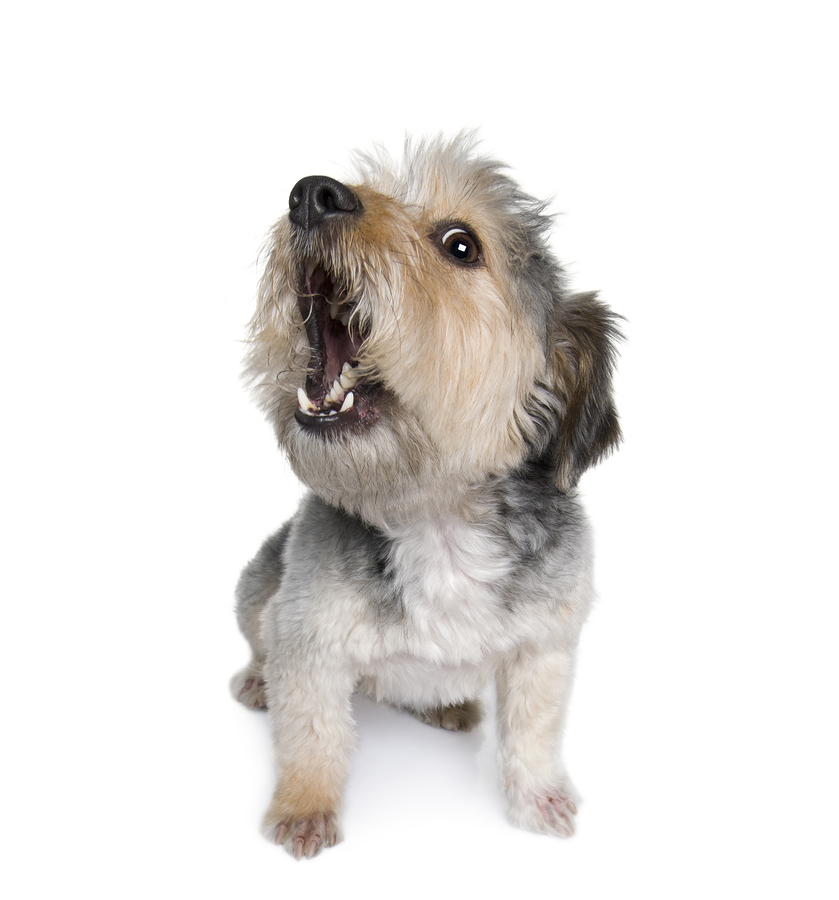“CAN HE HAVE CHICKEN?” I yelled, projecting over the commotion of the terrier barking and growling at me. He was safely behind a baby gate, something I had arranged ahead of time with my client. This was our first meeting.
“SURE!” the client yelled back.
I tossed a piece of freeze-dried chicken over the baby gate, behind the snarling terrier. He froze, then backed up, sniffing the ground for the fallen treat. He tentatively ate it, then resumed screaming at me, lunging at the gate. His hackles were raised and he stood stiff, with back legs stretched out behind him. He looked like he wanted to eat me alive. He was terrified.
I continued to toss treats behind him. I smiled confidently at my client, although I could see from her puzzled expression that she was confused as to my tactics. I motioned for her to wait, as I couldn’t exactly explain the science of what I was doing over the racket. After about 10 minutes, the dog stopped barking. He approached the gate and sat, finally calm. We weren’t best friends by any means, but we had the beginnings of a relationship.
Once our ears had stopped ringing, my client sighed. “He really is a sweet dog,” she said. “But he hates everyone outside the family. Why were you giving him treats for barking at you?”
“Your dog is aggressive,” I responded. “But he’s not acting that way because he’s a jerk. He’s afraid.”
“Afraid?” she laughed. “He’s not in the least bit afraid. He’s bitten three neighbors!”
When a dog is snarling and lunging, it can be hard to see the root of his behavior is actually fear.
Choices
If a dog is afraid, there are several ways he can react. He may cower, hide, or bolt for safety. This is a dog who hides behind you or ducks out the room when visitors arrive.
A dog can shut down. Sometimes you see this at a veterinarian’s office. A dog will allow the staff to do anything to him, but he looks miserable the entire time. He’s just waiting for the ordeal to be over.
Other dogs get vocal, adopting the philosophy that the best defense is a good offense. If something scares them, they’ll get big and scary and frighten it away so it leaves them alone. Because the display is so loud and assertive, you need to look to recognize the fear underneath the bravado.
Stress Signals
Here are some behaviors that indicate a dog is stressed:
- Lip licking
- Yawning
- Whining
- Looking away or turning away
- Cowering
- Tail tucked
- Ears flat
- Panting, then suddenly stopping panting (this means the stress is escalating)
- Whale eye – the dog turns away but still looks at the scary person, animal, or object, so you see a lot of white around the eye
- Barking
- An adrenaline shake off – the dog will shake as if he’s wet, but he’s not wet
- Forward, then backward body posture – the dog will lunge and bark, then backpedal
Always remember that behavior is fluid. It changes rapidly. Just because your dog whines and yawns doesn’t mean he’s having a panic attack. Look for clusters of stress signals, and always consider the context. What’s going on in your environment when you see your dog display stress signals?
To combat fear, you have to change the dog’s opinion. In the case of my client, the dog was afraid of me, but he loved chicken. The more freeze-dried chicken I gave him, the more I rose in his esteem. I changed his feelings toward me from fear to interest, then eventually to friendship as the lessons continued. This is the science of counterconditioning, changing the dog’s emotional response or feelings toward a stimulus. By the third lesson, he would greet me with wiggles and kisses.
Treating fearful aggression requires careful behavior modification and sometimes medication. So yes, there’s more to it than tossing treats. But recognizing fear as the source is the first step in understanding your dog and how to help him. Is your snarling, barking beast really the neighborhood terror? Or is he an insecure chicken at heart?
This article was reviewed/edited by board-certified veterinary behaviorist Dr. Kenneth Martin and/or veterinary technician specialist in behavior Debbie Martin, LVT.








